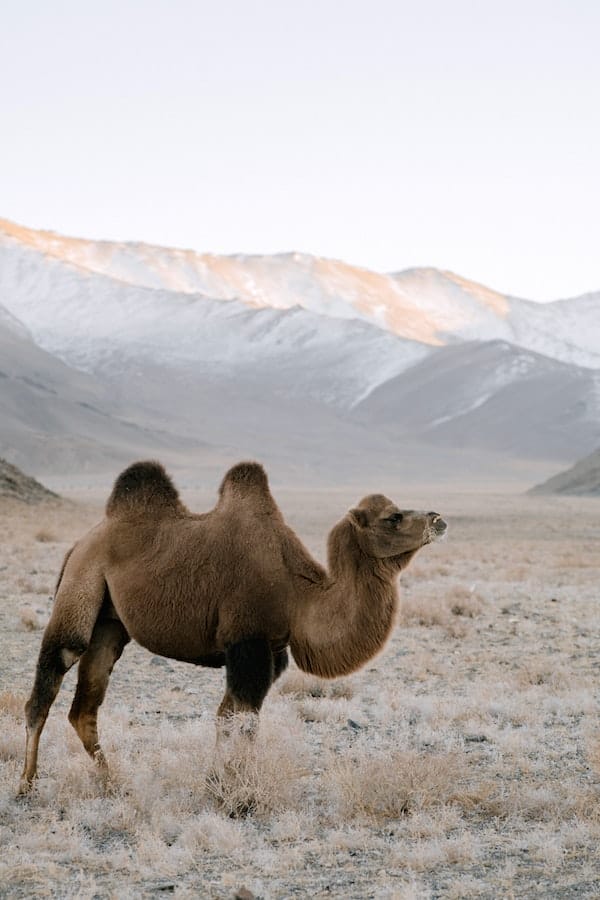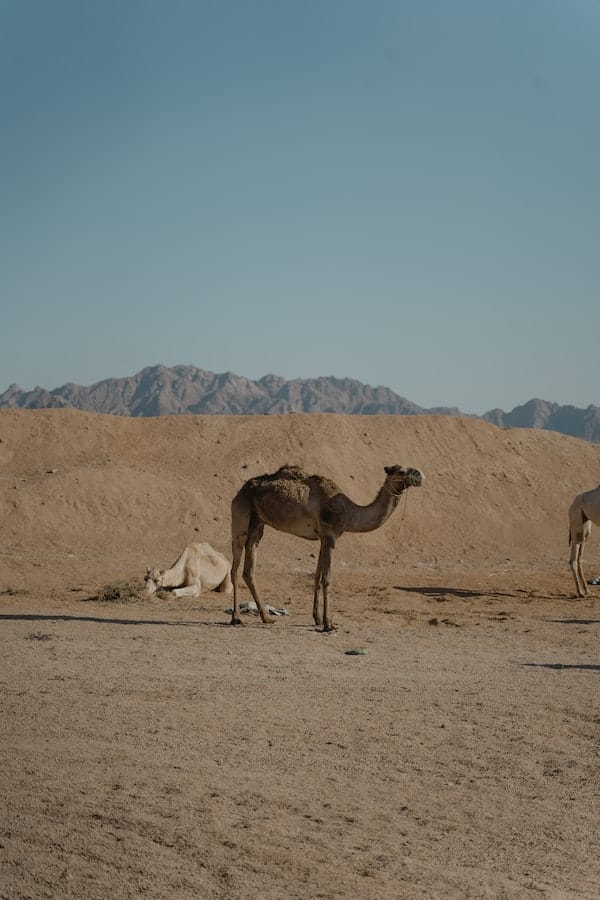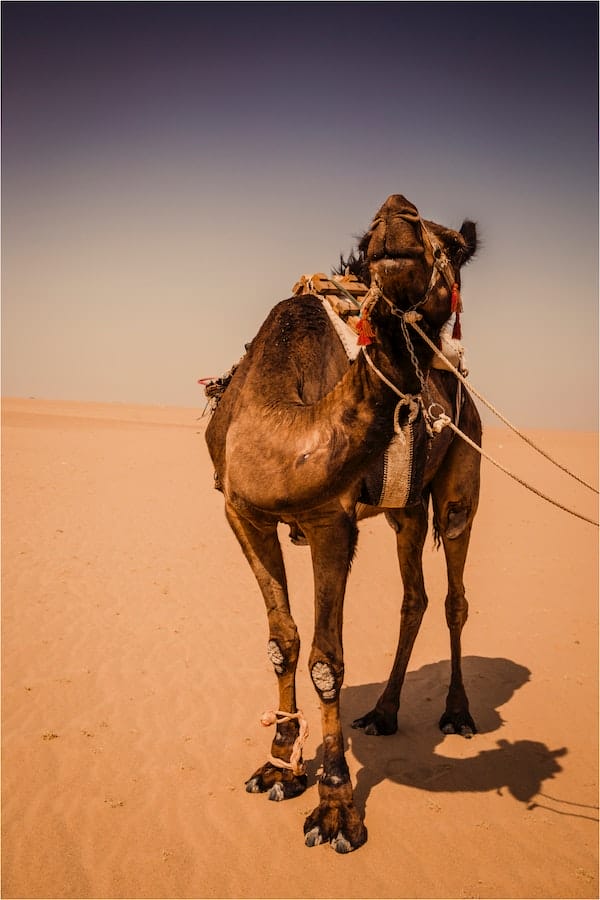
Camels are fascinating creatures! Often associated with deserts and caravans, camels have many unique characteristics that make them an incredible species.
From their impressive physical adaptations to their extraordinary behavior, camels have a long history of captivating people around the world.
Here we take a look at some amazing facts about this one-of-a-kind animal.
From their humps to their incredible stamina, read on to learn some interesting facts about camels!
Fact #1: Camels are not native to the Sahara Desert.
Despite the popular association of camels with the Sahara Desert, these animals are not actually native to this area.
Camels have first domesticated in the Middle East thousands of years ago, and it is believed that they were later brought to Africa by traders.
In addition, many camels in Africa are feral or semi-domesticated, meaning they are descended from domesticated animals that have gone wild.
Fact #2: The hump on a camel’s back is actually made of fat, not water.
Contrary to popular belief, the hump on a camel’s back is not filled with water.
Instead, it is made up of fat deposits that camels use as energy reserves during times of food scarcity.
This fatty hump can provide the animal with up to three weeks’ worth of sustenance! The shape and size of the hump can vary depending on the camel’s age and diet.
A fat and healthy hump can reach about 18 inches in length, while a dehydrated one will be much smaller.
In addition, some camels may have two humps instead of one!
Fact #3: Camels can go for up to two weeks without drinking water.

Camels are well-known for their incredible ability to survive in harsh desert climates.
This is due to the animal’s extraordinary adaptation of not needing to drink water as often as other animals.
A camel can go up to two weeks without drinking water, and they are able to survive on minimal amounts of plants and grasses that contain moisture.
In addition, camels have a special lining in their mouths that prevents the water from evaporating quickly.
This allows them to conserve as much moisture as possible when drinking!
Fact #4: Camels have three eyelids.
Camels have a unique adaptation for protecting their eyes from sandstorms and harsh winds in the desert.
They have three eyelids – two on top to protect their eyes from sand and one underneath that helps keep the moisture in their eyes when they are not blinking.
In addition, camels can close both of their nostrils independently, allowing them to reduce their intake of sand particles when the wind is blowing.
Fact #5: Camels can reach speeds of up to 40 miles per hour!
Camels are surprisingly fast animals and can reach speeds of up to 40 miles per hour!
This impressive speed is due to the camels’ long legs, which allow them to cover large distances quickly.
In addition, their specialized hooves allow the animal to keep its footing in the sand and navigate difficult terrain with ease.
Fact #6: Camels can close their nostrils to keep out sand and dust.
Camels have a unique adaptation that helps them survive in the desert – they can close their nostrils independently.
This allows them to reduce their intake of sand particles when the wind is blowing, as well as keep out dust and other airborne particles.
- Related post: Best Camel Tattoo Ideas & Designs
- Related post: The Top 10 Tallest Animals in the World
Fact #7: A camel’s coat can be either black or brown.

Camels have black or brown coat, depending on the animal’s age and diet.
The fur of young camels is usually light brown in color, while mature camels can be darker brown or even black.
In addition, many camel breeds also feature two-toned coats with white patches across their backs and legs.
Fact #8: A baby camel is called a calf.
A baby camel is called a calf, and they are typically born after a gestation period of 13 to 15 months.
Calves are usually quite precocious and can stand within an hour of being born. In addition, calves will begin to nurse just minutes after birth and will reach full size in about two years.
Fact #9: A group of camels is called a herd or a flock.
A group of camels is called a herd or a flock. The size of the herd can vary depending on the species, but it usually consists of several individuals.
Herds are typically led by an adult male, who will protect and care for the other members of the group.
Fact #10: Camels are used as working animals.
Camels are commonly used as working animals in many parts of the world, including the Middle East, Africa, and Asia.
These hardy creatures have been used to transport goods and people across long distances for centuries, as they can carry heavy loads over large areas with minimal effort.
Camels are also prized for their ability to withstand harsh desert climates and have been used for farming and herding livestock in areas with little access to water.
Fact #11: Bactrian camels are the only type of camel that can withstand cold weather.
Unlike other types of camels, Bactrian camels are able to withstand cold weather and can survive in temperatures as low as -20°C.
They have a thick double coat of fur that helps keep them warm in the winter months, as well as unique adaptations such as smaller hooves for better grip on icy surfaces.
Fact #12: Dromedary camels are the most common type of camel.
Dromedary camels are the most common type of camel and are typically found in hot desert climates.
They have a single hump on their back, which helps them store fat, and they can go for days without drinking water.
These camels also have long legs, allowing them to cover large distances quickly, as well as wide feet that help them stay stable on shifting sand.
Fact #13: Camel milk is a popular food.

Camel milk is a popular food in some parts of the world, including the Middle East and Africa.
It is rich in essential vitamins and minerals and has been known to improve digestion, boost immune systems, and even treat certain diseases.
Camel milk also contains high amounts of calcium, iron, magnesium, Vitamin C, and other important nutrients that help to keep the body healthy.
Additionally, camel milk is said to have a milder taste than cow’s milk and can be used in a variety of recipes.
Fact #14: Camels are important to some cultures and religions
Camels are an important part of many cultures and religions around the world, with references found in both ancient and modern texts.
For example, in the Bible, camels are mentioned numerous times as a symbol of wealth and power.
Additionally, camels play an important role in Islamic culture and are often used in traditional celebrations and festivals.
In some parts of the world, these animals are even seen as lucky charms and can be found on jewelry or clothing items.
Overall, camels are an incredible species with many fascinating traits and abilities.
From their adaptability to their strong work ethic, these amazing creatures are truly remarkable animals.


GIPHY App Key not set. Please check settings